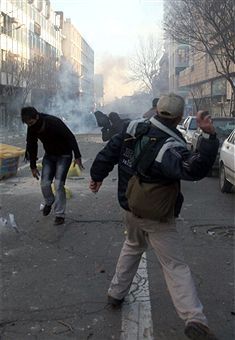 Revolutions are exciting when they happen to other leaders. When they target the
government you lead, then they become decidedly less appealing. That seems to be Mahmoud Ahmadinejad’s view. Only last week the Iranian President told the Egyptian protesters that they had the
right to express their own opinions. The Iranian regime’s short-sighted glee, however, has quickly turned to fear. And it shows: the regime has unleashed the police onto protesting crowds in Iran,
killing one and wounding several.
Revolutions are exciting when they happen to other leaders. When they target the
government you lead, then they become decidedly less appealing. That seems to be Mahmoud Ahmadinejad’s view. Only last week the Iranian President told the Egyptian protesters that they had the
right to express their own opinions. The Iranian regime’s short-sighted glee, however, has quickly turned to fear. And it shows: the regime has unleashed the police onto protesting crowds in Iran,
killing one and wounding several.
Unlike Hosni Mubarak, Iran’s leaders know what it is like to be a revolutionary movement – and they have used their inside knowledge to lethal effect. Like Lenin and Stalin, they have taken revolutionary paranoia into government. While the Egyptian army refused to kill the protesters, the Iranian army, police and para-military forces have no such restraint.
But, because they know what makes a revolution successful, the regime must also be worried. The ingredients that allowed the mullahs to seize power in 1979 – repression, poverty, corruption, and a sense that the protesters are being carried by modernity – are resurfacing in Tehran, Shiraz and Isfahan.
Despite sinister warnings, thousands of protesters have turned out. Courtesy of their Egyptian brothers and the West’s inaction, the Iranian protesters have a new ideology: a belief that they can restore democracy. They do not need or want the West’s help, and, for that reason, they will be hard to quash.






Comments